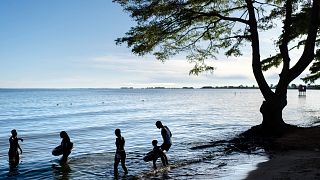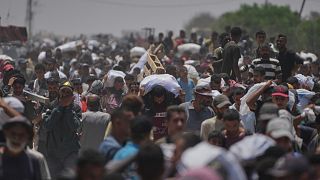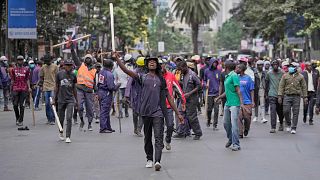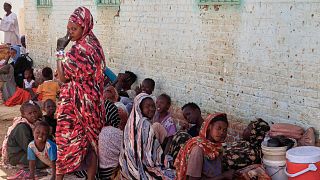Cameroon
André Nkoudi is a fisherman who lives in Mangamba, a village on the Cameroon coast.
He’s out patrolling the rivers around his village at least once a week.
Nkoudi looks for frogs' nests, tadpoles, frogs caught in the traps of fishermen’s nets or footprints that indicate the presence of poachers hunting the Goliath frog, known officially as Conraua goliath.
Nkoudi wasn’t always so concerned for the welfare of the amphibian, having previously been a hunter.
Now he monitors the species for scientists hoping to protect them.
Today, he notices a small frog caught in a net planted in a river. He takes a photo which he sends to the researchers. Then, crucially, he releases the frog.
The Goliath frogs are the world’s largest. They’re only found only in the tropical rainforest of central Africa, within the southwestern part of Cameroon and north of Equatorial Guinea.
Some of the adult frogs weigh several kilograms and measure more than 33 centimetres in length, when fully grown.
Nkoudi has noticed they’ve diminished over the years.
“In 2003, when I walked in here, as soon as I got there, I was going to catch at least 20 frogs. There were many. We didn’t have to go far to hunt frogs. We just had to walk from there to there to catch even 15, and I went home. Now I walk miles and I don’t even see one. Because a lot of people hunt now too."
Now Nkoudi is involved in trying to inform other villagers about the importance of protecting the endangered frog.
“We have been informed that this frog is important to the government. So, I decided not to go into the water anymore to hunt frogs, because the government took control. So, I’m no longer involved in the frog hunt. And I explain to people to be careful, to stop hunting frogs because there is now a law that protects frogs. The government, the projects, take care of the frogs. I stopped hunting them. That’s how I educate the people in the village,” says Nkoudi.
The Conservation Leadership Programme, an NGO, is now trying to improve data collection so the scientific community has more evidence-based information about the frogs' welfare and environment.
The group’s Ecological Monitor, Robillard Kouekam, joins Nkoudi to measure and weigh the frogs and detail where they were found.
“These data will, at the end of the investigation help to map the presence of frogs in the study environment. The measurements will allow us to model the growth parameters, to find the condition factor and the coefficient of allometry (organ measurements), in short to determine whether the location is favourable for them or not. These data will, at the end of the investigation help to map the presence of frogs in the study environment. The measurements will allow us to model the growth parameters, to find the condition factor and the coefficient of allometry (organ measurements), in short to determine whether the location is favourable for them or not,” he says.
According to Kouekam, local communities will be offered alternative ways of making an income.
But the money which can be earned from hunting the goliath frog means it will be difficult to persuade villagers they should be protected, not hunted.
Nkoudi explains: “It depends on the size. The big ones are at 6,000 CFA francs ($10), the small ones at 5,000 CFA francs ($8.40). Other smaller ones are at 2,000 CFA francs ($3.40). That’s how we sold these frogs here. It helped us manage our lives. I, for example, have two kids in college. It was the money from those frogs that allowed me to send them to school.”
Kouekam says new forms of farming can be introduced.
“We have a snail breeding project. These people who hunted frogs will be introduced to the breeding of snails, which will generate income,” he says.
Environmentalist Ghislain Fomou says stricter measures are needed.
“The middle ground will, first, be better regulated access to this type of living species, sampling must be controlled, I think the problem is when going to a high level of sampling that is not in coordination with the degree and the level of reproduction, this is what constitutes a threat in the first place.”
The goliath frog has been classified as an ‘endangered species’ by IUCN and as a protected species of class ‘A’ according to the Cameroonian wildlife law.
The total population of goliath frogs has dropped by at least 50 percent over the last 15 years, according to the International Union for Conservation of Nature (IUCN).
According to local fishermen, these frogs are caught for local consumption, but they’re also believed to be trafficked to neighbouring countries like Nigeria.













02:05
In Zimbabwe, metal scrap collecting is reducing environmental pollution
11:14
Rwanda Walks Away: what’s behind the Central Africa rift? [Business Africa]
00:50
New documentary shines light on plight of pangolins, one of the world's most trafficked mamals
01:06
Experts warn of an increase in Glacier-related risks from climate change
00:10
Elephant spotted in Senegalese park gives hope to conservationists
00:57
Nigeria crisis: 20,000 flee Marte after militant attacks